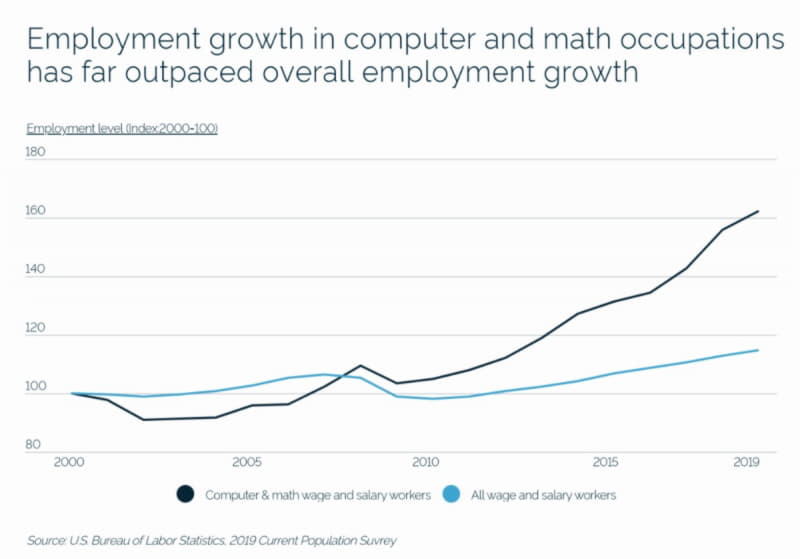California’s Silicon Valley has long served as the nation’s technology hub. But while Silicon Valley remains a global leader for tech firms and jobs, technology’s transformative impact on the economy and society is driving job growth across the United States. Led by employers—and even entire industries—that did not exist a generation ago, many of the fastest-growing industries in the U.S. are in the fields of science, technology, and mathematics. The long-running trend of growth in these fields shows few signs of slowing down.

According to data from the U.S. Bureau of Labor Statistics, job growth in computer and math occupations has outpaced the national average since 2008. The gap has only grown larger over the last decade, and the trend is likely to continue. According to the BLS, employment in computer and information technology occupations is projected to grow by 11 percent over the next decade, adding more than 500,000 jobs to the economy. And unlike many jobs that have been disrupted by the COVID-19 pandemic, computer and IT occupations are largely remote-friendly, which positions them well for continued growth.

Some states have seen the benefit of this job growth more than others. Driven by a high number of firms specializing in defense, information technology, and other professional services for the federal government, Virginia leads the nation with 5.6 percent of its workers employed in computer and math occupations. Washington—home to a strong aerospace engineering sector and tech giants Microsoft and Amazon—is second, with Maryland, Colorado, and Massachusetts following behind.
However, statewide trends do not tell the whole story of tech employment either, as employers in high-tech fields tend to cluster in local regions where the labor market can supply the specialized knowledge required for those positions. This often means that metro areas with many well-established innovative companies, strong institutions of higher education, or both—like Silicon Valley—tend to be the areas that incubate many of the firms that drive job growth in tech.
To see which metro areas have the most tech jobs, researchers at Spanning used data from the BLS’s 2019 Occupational Employment Statistics (OES) Survey to identify metros with the largest share of employment in computer and math occupations. The researchers also calculated the total number of jobs, wages, and wage premiums for computer and math occupations in each metro. To improve relevance, metros were also grouped into population cohorts of small (100,000–349,999 residents), midsize (350,000–999,999 residents), and large (1,000,000 or more residents).
The analysis found that the Philadelphia metropolitan area employs 99,960 tech workers who earn a median annual wage of $90,290. The median annual wage for all occupations in the Philadelphia metro is $43,840, which means tech workers in Philadelphia enjoy a wage premium of +106.0% over all occupations.
- Share of employment in computer & math occupations: 3.5%
- Total employment in computer & math occupations: 99,960
- Median annual wage for computer & math occupations: $90,290
- Median annual wage for all occupations: $43,840
- Computer & math wage premium: +106.0%
For reference, here are the statistics for the entire United States:
- Share of employment in computer & math occupations: 3.1%
- Total employment in computer & math occupations: 4,552,880
- Median annual wage for computer & math occupations: $88,340
- Median annual wage for all occupations: $39,810
- Computer & math wage premium: +121.9%
For more information, a detailed methodology, and complete results, you can find the original report on Spanning’s website: https://spanning.com/









